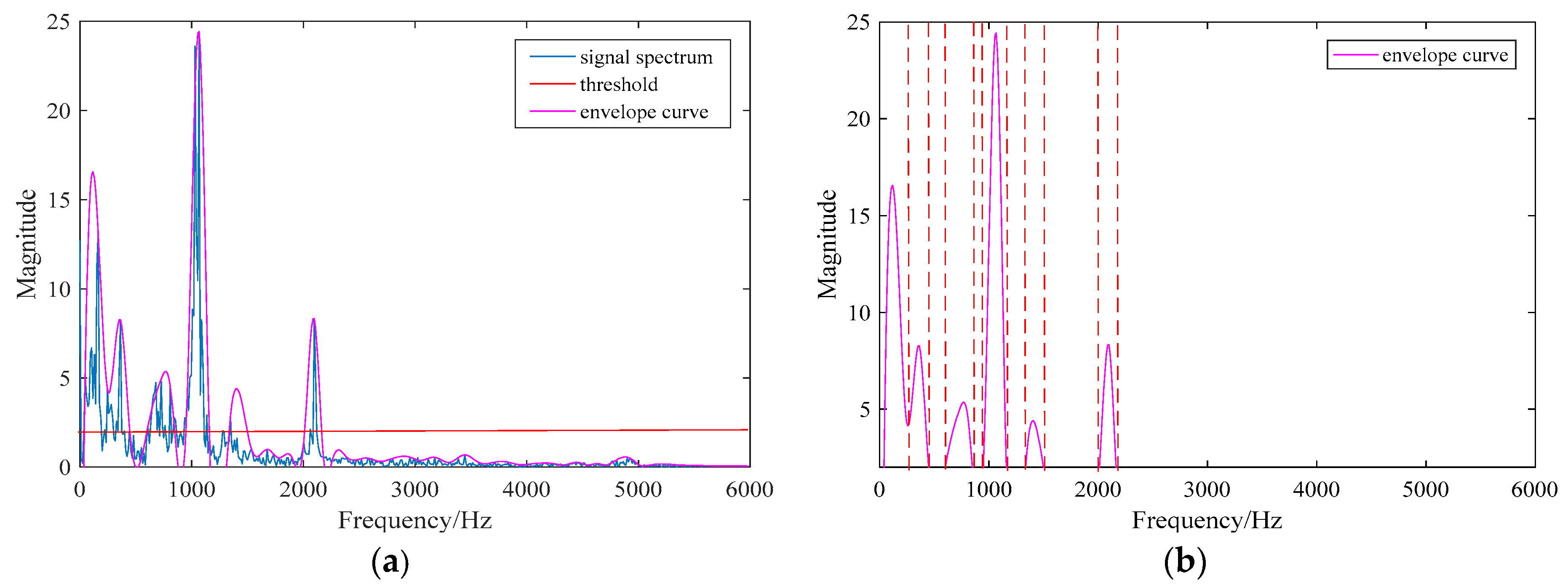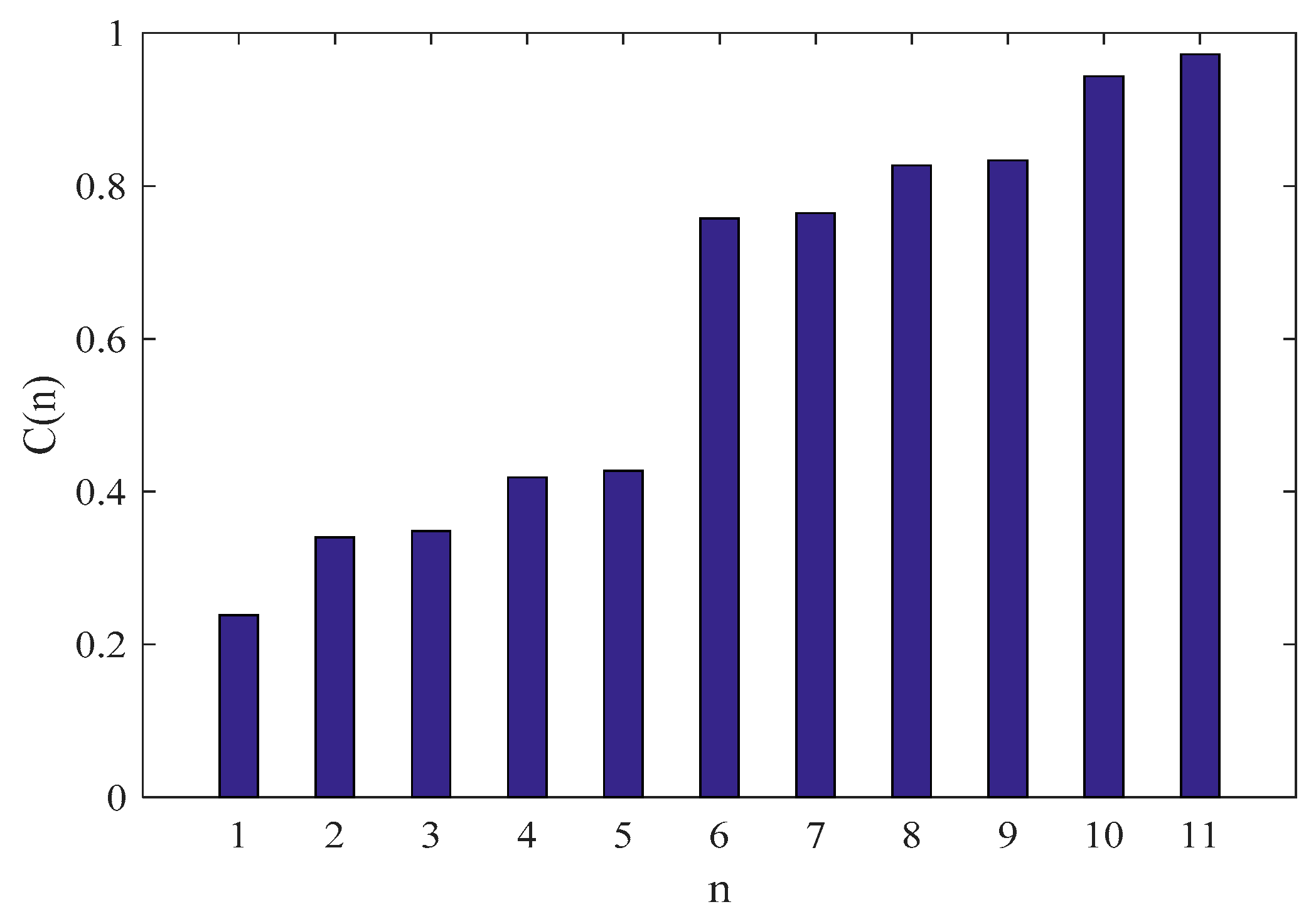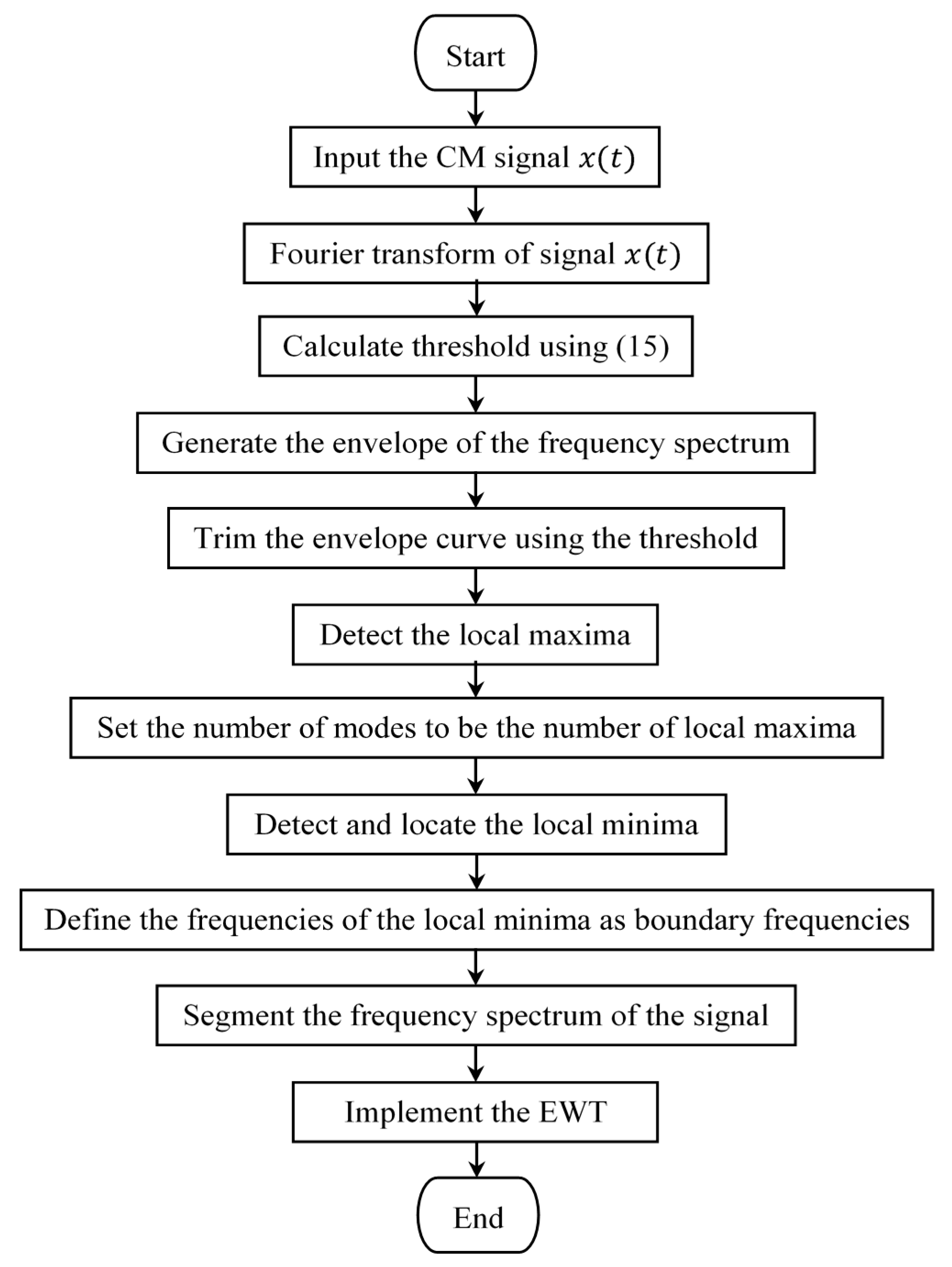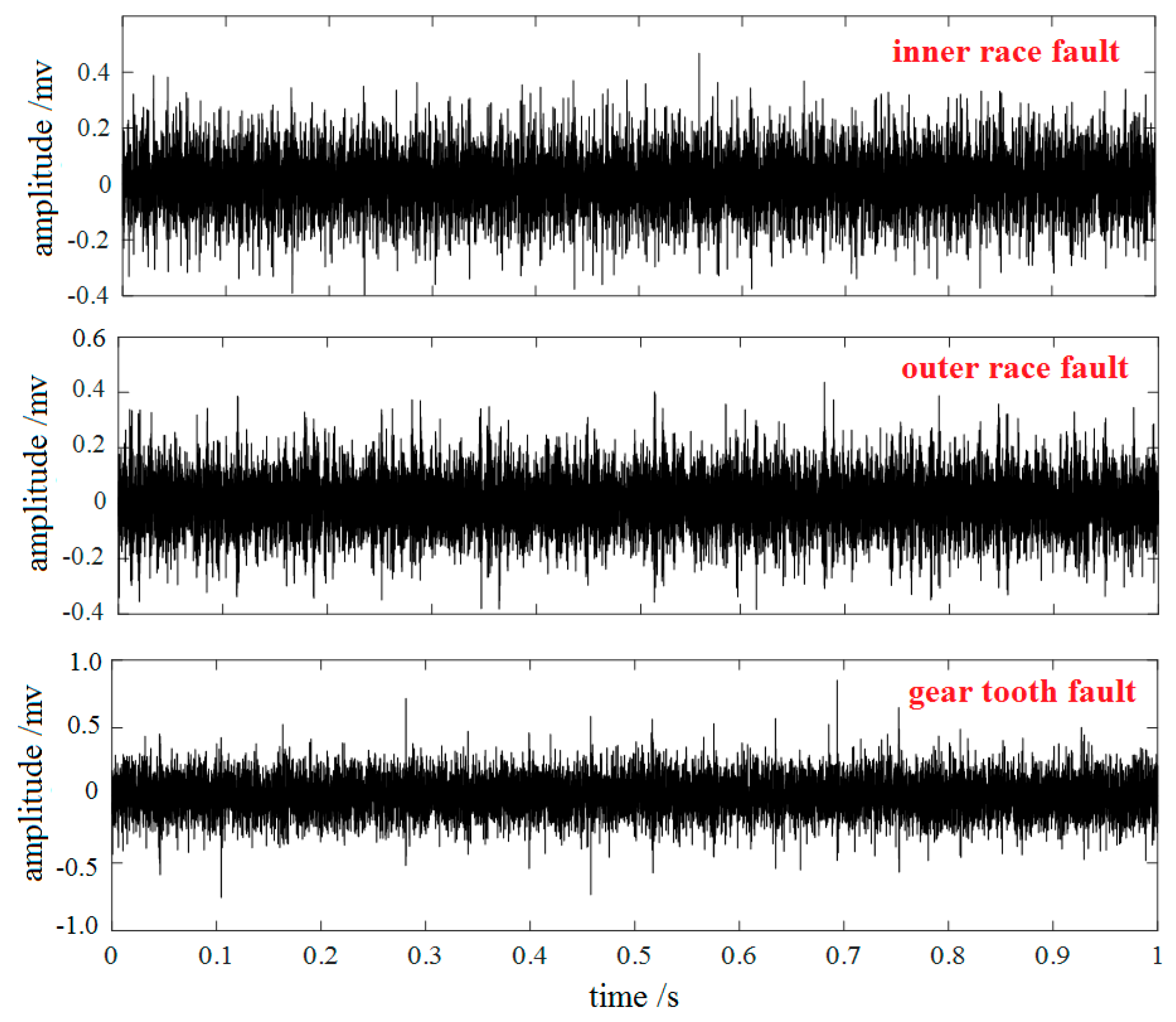An Enhanced Empirical Wavelet Transform for Features Extraction from Wind Turbine Condition Monitoring Signals
Abstract
:1. Introduction
- the recursive calculations lower the computational efficiency of the EMD algorithms;
- the error developed in envelope estimation will spread in the recursive calculation results and consequently decrease the accuracy of the decomposition;
- (1)
- the valid information of a signal is dominated by those frequency components with significant amplitudes; and
- (2)
- those frequency components with significant amplitudes can be readily identified from the envelope of the original frequency spectrum of the signal.
2. Fundamental Theory and Limitations of the EWT
3. Enhanced Empirical Wavelet Transform
- Step 1.:
- Implement the Fourier transform of , i.e.,where denotes the half number of data contained in signal .
- Step 2:
- Detect the local extra values of .
- Step 3:
- Generate the envelope curve of the Fourier spectrum by using the cubic spline interpolation method.
- Step 4:
- Calculate the following thresholdwhere and are respectively the maximum and minimum magnitudes in the frequency spectrum and is inversely proportional to the signal-to-noise (SNR). Herein, the constant is used to control the level of the threshold, i.e., the larger the value of , the higher the level of the threshold tends to be. In this paper, was taken to be 0.1 based on the assumption that the signal-to-noise ratio of WT CM signals is higher than 85 dB and .
- Step 5:
- Trim the envelope curve using the calculated threshold and detect all extras in the trimmed envelope curve.
- Step 6:
- Locate all local maximum points. The number of them is used to define the number of EWT modes, and their frequencies are used to define the central frequencies of the modes.
- Step 7:
- Locate all the local minimal points and sort them in ascending order, i.e., . They are used to segment the frequency spectrum.
- (1)
- attributed to the trimming process that is implemented at Step 5, the number of modes can be readily determined based on the actual situation of the signal;
- (2)
- since the local extras in the trimmed envelope curve are applied to define the boundaries of the modes, spectrum segmentation can be easily implemented.
4. Verification Tests of the Enhanced EWT
- the bearing data were collected from a test rig consisting of a motor speed controller, a 2 HP motor, and a generator [23]. Both inner race and outer race faults were emulated on the motor bearing of the test rig. The acceleration signals were collected by using a sampling frequency of 12 kHz when the motor rotated at 1750 rev/min;
- the gear vibration data were collected from a test rig consisting of a gearbox, a load mechanism, a triaxial accelerometer, and four shock absorbers [24]. The accelerometer was installed on the case of the gearbox. The acceleration signals were recorded by using a sampling frequency of 16 KHz when the input shaft of the gearbox rotated at 1400 rev/min.
- (1)
- the fault-related periodic impact features contained in the signals have been explicitly detected by the enhanced EWT. From the clear time intervals between these periodic impact features, the characteristic frequency of the fault can be easily estimated, and, therefore, the type of the fault can be correctly diagnosed without any difficulty once the specification parameters of the bearing and gear are known. By contrast, the impact features are smeared or even buried by background ‘noise’ in the time-frequency maps derived by the conventional EWT. As a consequence, the time intervals between them are not easy to estimate. That inevitably increases the difficulty of signal interpretation;
- (2)
- the majority of interference components that are present in the conventional EWT results are absent from the time-frequency maps derived from the enhanced EWT. This significantly highlights the principal frequency components while it depresses the unimportant interference and noise items in the signal, thus making the time-frequency maps of the signal more tidy and comprehensible.
5. Conclusions
- The conventional EWT is lowered due to lacking an appropriate method to segment the frequency spectrum of the signal being investigated. Consequently, the frequency spectrum of the signal could not be segmented properly. Inappropriate segmentation of the signal spectrum would not only decrease the computing efficiency of the EWT, but also lower the accuracy of feature extraction;
- With the aid of the proposed spectrum segmentation method, the number of modes and the frequency boundaries of every EWT mode can be readily determined. Moreover, it can be guaranteed that every EWT mode derived by using the enhanced method will have an exact physical meaning that corresponds to either WT operation or structural integrity features. By contrast, unidentified information could be included in the results by the conventional EWT, which would raise the difficulty of signal interpretation or even mislead WT CM;
- The experiment has shown that the fault-related time-frequency features of the signals can be more precisely extracted by the enhanced EWT, despite the considerable noise contained in the signals and the lack of pre-knowledge about the machine being investigated. This suggests that in contrast to the conventional EWT, the enhanced EWT needs less manual participation and thus has potential to be a fully data driven WT CM signal processing technique.
Acknowledgments
Author Contributions
Conflicts of Interest
References
- Yang, W.; Tavner, P.J.; Tian, W. Wind Turbine Condition Monitoring based on an Improved Spline-Kernelled Chirplet Transform. IEEE Trans. Ind. Electron. 2015, 62, 6565–6574. [Google Scholar] [CrossRef]
- Yang, W.; Little, C.; Tavner, P.; Court, R. Data-driven technique for interpreting wind turbine condition monitoring signals. IET Renew. Power Gener. 2014, 8, 151–159. [Google Scholar] [CrossRef]
- Barton, J.P.; Watson, S.J. Analysis of electrical power data for condition monitoring of a small wind turbine. IET Renew. Power Gener. 2013, 7, 341–349. [Google Scholar] [CrossRef]
- Yang, W.; Tavner, P.; Crabtree, C.; Feng, Y.; Qiu, Y. Wind turbine condition monitoring: Technical and commercial challenges. Wind Energy 2014, 17, 673–693. [Google Scholar] [CrossRef]
- Tchakoua, P.; Wamkeue, R.; Ouhrouche, M.; Slaoui-Hasnaoui, F.; Tameghe, T.A.; Ekemb, G. Wind Turbine Condition Monitoring: State-of-the-Art Review, New Trends, and Future Challenges. Energies 2014, 7, 2595–2630. [Google Scholar]
- Antoni, J. The spectral kurtosis: A useful tool for characterising non-stationary signals. Mech. Syst. Signal Process. 2006, 20, 282–307. [Google Scholar] [CrossRef]
- Yang, W.; Little, C.; Court, R. S-Transform and its contribution to wind turbine condition monitoring. Renew. Energy 2014, 62, 137–146. [Google Scholar] [CrossRef]
- Sheen, Y.T. An envelope analysis based on the resonance modes of the mechanical system for the bearing defect diagnosis. Measurement 2010, 43, 912–934. [Google Scholar] [CrossRef]
- He, W.; Jiang, Z.N.; Feng, K. Bearing fault detection based on optimal wavelet filter and sparse code shrinkage. Measurement 2009, 42, 1092–1102. [Google Scholar] [CrossRef]
- Chiementin, X.; Bolaers, F.; Dron, J.P. Early Detection of Fatigue Damage on Rolling Element Bearings Using Adapted Wavelet. ASME J. Vib. Acoust. 2007, 129, 495–506. [Google Scholar] [CrossRef]
- Barszcz, T.; Randall, R.B. Application of spectral kurtosis for detection of a tooth crack in the planetary gear of a wind turbine. Mech. Syst. Signal Process. 2009, 23, 1352–1365. [Google Scholar] [CrossRef]
- Li, H.; Zhang, Y.; Zheng, H. Hilbert-Huang transform and marginal spectrum for detection and diagnosis of localized defects in roller bearings. J. Mech. Sci. Technol. 2009, 23, 291–301. [Google Scholar] [CrossRef]
- Van, M.; Kang, H.J.; Shin, K.S. Rolling element bearing fault diagnosis based on non-local means de-noising and empirical mode decomposition. IET Sci. Meas. Technol. 2014, 8, 571–578. [Google Scholar] [CrossRef]
- Huang, N.E.; Shen, Z.; Long, S.R.; Wu, M.C.; Shih, H.H.; Zheng, Q.; Yen, N.C.; Tung, C.C.; Liu, H.H. The empirical mode decomposition and the Hilbert spectrum for nonlinear and non-stationary time series analysis. Proc. R. Soc. 1998, 903–995. [Google Scholar] [CrossRef]
- Yang, Y.; Cheng, J.S.; Zhang, K. An ensemble local means decomposition method and its application to local rub-impact fault diagnosis of the rotor systems. Measurement 2012, 45, 561–570. [Google Scholar] [CrossRef]
- Wu, Z.H.; Huang, N.E. Ensemble empirical mode decomposition: A noise assisted data analysis method. Adv. Adapt. Data Anal. 2009, 1, 1–41. [Google Scholar] [CrossRef]
- Rilling, G.; Flandrin, P.; Goncalvès, P. On Empirical Mode Decomposition and Its Algorithms. Available online: http://perso.ens-lyon.fr/patrick.flandrin/NSIP03 (accessed on 10 July 2017).
- Li, R.; He, D. Rotational machine health monitoring and fault detection using EMD-based acoustic emission feature quantification. IEEE Trans. Instrum. Meas. 2012, 61, 990–1001. [Google Scholar] [CrossRef]
- Yang, W.; Court, R.; Tavner, P.; Crabtree, C. Bivariate empirical mode decomposition and its contribution to wind turbine condition monitoring. J. Sound Vib. 2011, 330, 3766–3782. [Google Scholar] [CrossRef]
- Gilles, J. Empirical Wavelet Transform. IEEE Trans. Signal Proc. 2013, 61, 3999–4010. [Google Scholar] [CrossRef]
- Kedadouche, M.; Thomas, M.; Tahan, A. A comparative study between Empirical Wavelet Transforms and Empirical Mode Decomposition Methods: Application to bearing defect diagnosis. Mech. Syst. Signal Process. 2016, 81, 88–107. [Google Scholar] [CrossRef]
- Daubechies, I. Ten Lectures on Wavelets; Society for Industrial and Applied Mathematics: Philadelphia, PA, USA, 1992. [Google Scholar]
- Case Western Reserve University Bearing Data Center Website. Case Western Reserve University. Available online: http://csegroups.case.edu/bearingdatacenter/pages/apparatus-procedures (accessed on 12 November 2014).
- Rafiee, J.; Arvani, F.; Harifi, A.; Sadeghi, H.M. Intelligent condition monitoring of a gearbox using artificial neural network. Mech. Syst. Signal Process. 2007, 21, 1746–1754. [Google Scholar] [CrossRef]










© 2017 by the authors. Licensee MDPI, Basel, Switzerland. This article is an open access article distributed under the terms and conditions of the Creative Commons Attribution (CC BY) license (http://creativecommons.org/licenses/by/4.0/).
Share and Cite
Shi, P.; Yang, W.; Sheng, M.; Wang, M. An Enhanced Empirical Wavelet Transform for Features Extraction from Wind Turbine Condition Monitoring Signals. Energies 2017, 10, 972. https://doi.org/10.3390/en10070972
Shi P, Yang W, Sheng M, Wang M. An Enhanced Empirical Wavelet Transform for Features Extraction from Wind Turbine Condition Monitoring Signals. Energies. 2017; 10(7):972. https://doi.org/10.3390/en10070972
Chicago/Turabian StyleShi, Pu, Wenxian Yang, Meiping Sheng, and Minqing Wang. 2017. "An Enhanced Empirical Wavelet Transform for Features Extraction from Wind Turbine Condition Monitoring Signals" Energies 10, no. 7: 972. https://doi.org/10.3390/en10070972




